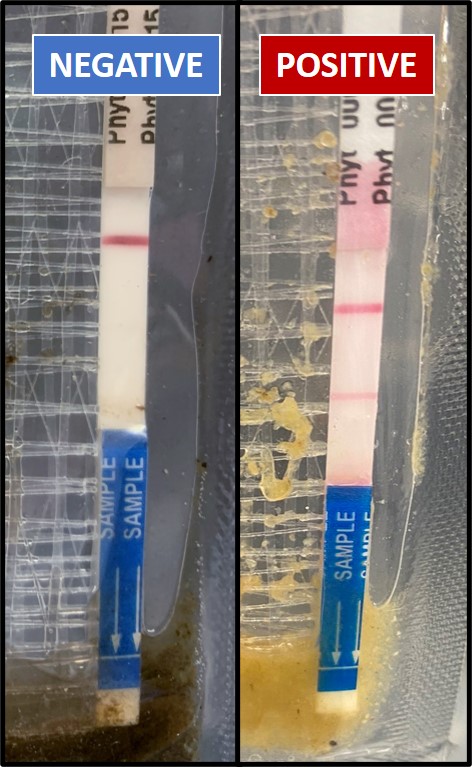
Using pathogen testing kits for plant disease diagnosis
When plants start dying or showing symptoms of a disease, a quick diagnosis is important to reduce disease spread through a crop. It is best to have the problem accurately diagnosed within a University, state, or private diagnostic laboratory. However, in-house pathogen testing kits can give cost-effective and rapid results for some diseases. The tests use antibodies to detect specific pathogen proteins and work much like a “home-pregnancy test” for plant diseases. There are two main types of antibody tests: ImmunoStrip® produced by Agdia, Inc. (www.agdia.com) and lateral flow rapid tests such as Pocket Diagnostic® (www.pocketdiagnostic.com) and ALERT-LF™ (www.bio-world.com). The tests work in a similar manner and pathogen-specific tests are available for the more common viruses affecting ornamental plants including Cucumber Mosaic Virus (CMV), Impatiens Necrotic Spot Virus (INSV), Tomato Spotted Wilt Virus (TSWV), Tobacco Mosaic Virus (TMV), Hosta Virus X (HVX), and many more. There are also tests for some bacterial pathogens including Erwinia amylovora, cause of fire blight, and Xanthomonas hortorum pv. pelargonii, cause of bacterial blight of geranium, as well as a test for Phytophthora, a major root and crown rot pathogen. The Phytophthora test detects the pathogen at the genus level and cannot be used to identify a specific Phytophthora species.
The in-house (or in-field/in-greenhouse) tests are easy to use and can provide results within 5-30 minutes. For both the strip and lateral flow tests, a tissue sample is ground within a buffer solution provided within the test kit. Then, either a few drops of the plant tissue extract are placed within the well of the lateral flow test device or an ImmunoStrip® is inserted into the sample bag. The plant extract solution will be absorbed and wicked across or up the test strip. If the pathogen is present, two lines will appear on the test strip (i.e., positive result). If only one line appears, this indicates the test is working correctly, but the pathogen is not present within the sample (i.e., negative result). See the image showing both negative and positive results using the ImmunoStrip® test for Phytophthora. If no lines appear, the test is not working correctly, and results cannot be interpreted. For best results, let the sample and the testing kit components come to room-temperature before using. Also, do not overload the buffer with too much plant tissue and only use tissues showing disease symptoms. See the company webpages for more information on the testing kits, as well as videos and instructions on how to perform the tests. If conducted correctly, the pathogen test kits can provide quick identification of a disease so that infected plants can be discarded immediately, and disease management options can be initiated to reduce spread to surrounding plants within the production facility.
*Please Note: The mention of specific companies or testing products does not constitute an endorsement or recommendation of the product nor discriminates against similar products not mentioned.

Jean Williams-Woodward
Associate Professor and Extension Plant Pathologist, University of WyomingJean is an Associate Professor, Extension Plant Pathologist, and Director of the the Extension Plant Diagnostic Lab at the University of Wyoming beginning in 2025. Jean was previously at the University of Georgia for 29 years as an Extension Plant Pathologist providing plant disease diagnosis and management recommendations for ornamental plants in greenhouses, nurseries, and landscapes. She brings over 29 years of experience in working with ornamental plant producers and extension outreach providing education programs and on-site plant problem diagnostics.
